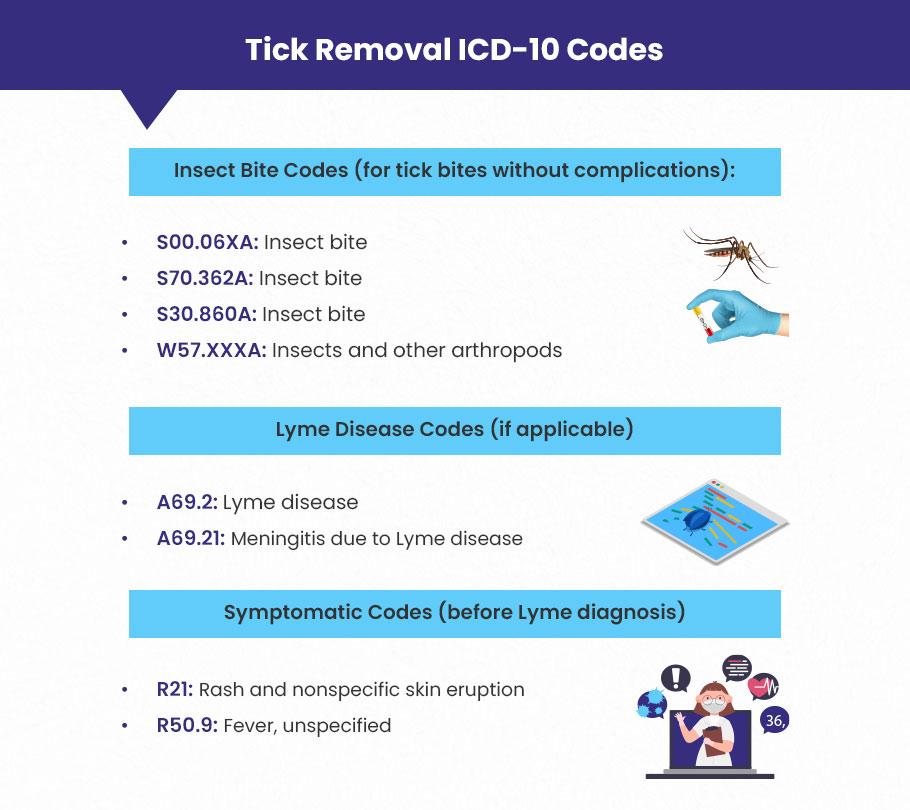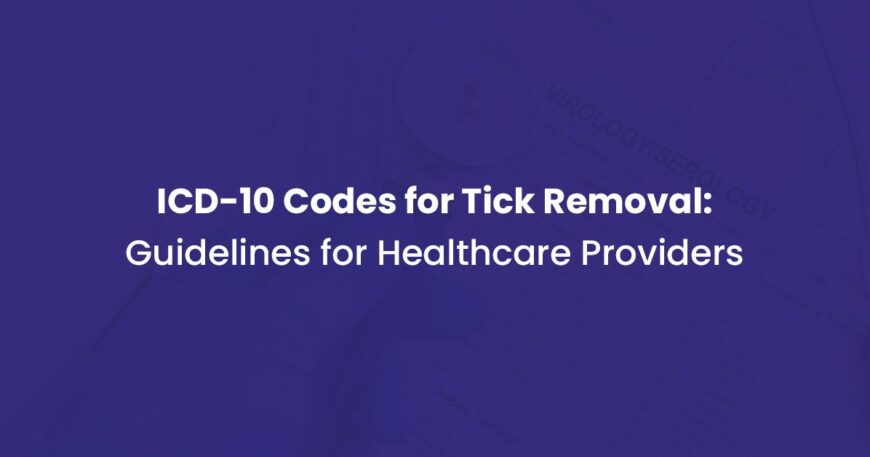When a patient comes to your office to have a tick removed, you take out the tick and write down details like the type of tick and how it was removed.
Was the tick removal process easy, difficult, or complicated?
You must write down and use the correct ICD-10 codes for each item to prevent claim rejections from the payers.
This blog will explain ICD-10 codes for tick removal, how to bill for tick removal services correctly, and some useful tips for healthcare providers.
ICD-10 Codes for Tick Removal 🐜
When treating tick bites, it is important to use the correct ICD-10 codes. These codes should show the bite and any complications that could possibly happen, like Lyme disease. Below are the most relevant “tick removal” ICD-10 codes for different scenarios:
Insect Bite Codes (for tick bites without complications):
- S00.06XA: Insect bite (nonvenomous) of the scalp, initial encounter
- S70.362A: Insect bite (nonvenomous), left thigh, initial encounter
- S30.860A: Insect bite (nonvenomous) of the lower back and pelvis, initial encounter
- W57.XXXA: Bitten or stung by nonvenomous insects and other nonvenomous arthropods, initial encounter
Lyme Disease Codes (if applicable)
- A69.2: Lyme disease
- A69.21: Meningitis due to Lyme disease
Symptomatic Codes (before Lyme diagnosis)
- R21: Rash and nonspecific skin eruption
- R50.9: Fever, unspecified
Need help with ICD-10 coding for Tick Removal?
ProcareMedEx’s medical coding experts are here to help you!

How to Bill Tick Removal ICD-10 Codes
The billing process for tick removal depends on the complexity of the procedure. Here is a step-by-step guide:
1. Determine the Nature of the Removal
- If the tick is removed with simple tools like tweezers, bill using an Evaluation and Management (E/M) code.
- Example: 99212 (evaluation for an established patient with straightforward medical problems).
- If the removal requires an incision or more complex procedures, use surgical procedure codes:
- 10120: Incision and removal of a foreign body, subcutaneous tissue, simple
- 10121: Incision and removal of a foreign body, subcutaneous tissue, complicated
2. Select Correct Diagnosis Codes
- Start with the injury code to describe the location of the bite (e.g., S70.362A for a left thigh bite).
- Follow with an external cause code to indicate the cause (e.g., W57.XXXA for being bitten by a nonvenomous insect).
3. Document the Accurate Details
- Medical records must include detailed documentation of the procedure, time spent, any complications, and symptoms to support the codes used.
Scenarios for Billing ICD-10 Codes for Tick Removal
Scenario 1: Simple Removal
- Tick is simple and removed using tweezers
- Takes 10-19 minutes for successful removal
- 99212 (E/M code for a straightforward visit)
The patient arrives with a small issue and needs a simple procedure to remove a tick.
The signs are fever, headache, and a skin rash or other general condition.
The provider sees a dark spot in the area of the body that is affected. After testing, he takes out the tick from the body in 10 to 19 minutes.
Keep in mind that there is no code for a simple removal with tweezers.
The provider will charge for the simple tick removal by using an E/M code and a diagnosis code for the office visit or other outpatient service.
Let us see how to code and bill the process:
- Case: A patient presents with a tick on the left thigh, and the provider removes it using tweezers.
- Procedure Code: 99212 (E/M code for a straightforward visit)
- Diagnosis Codes:
- S70.362A (Insect bite, left thigh)
- W57.XXXA (Bitten by nonvenomous insect)
Scenario 2: Complicated Removal
- Tick’s head is in the patient’s body
- Requires 40 minutes to remove it
- 99213 (for more detailed E/M service)
The second scenario is a difficult situation where the tick’s head is inside the patient’s body and the rest of the tick is outside.
Removing this tick takes up to 40 minutes, which is longer than in the first situation.
The provider needs to record the time to get paid correctly.
If there is no long procedure or testing needed, the provider will charge for the tick removal service using an E/M code, just like in the first example.
Here is how a provider will code and bill this:
- Case: A patient presents with a deeply embedded tick requiring more time and effort to remove.
- Procedure Code: 99213 (for more detailed E/M service)
- Diagnosis Codes:
- S70.362A (Insect bite, left thigh)
- W57.XXXA (Bitten by nonvenomous insect)
Scenario 3: Incision Required
- The tick is deeply embedded in the body
- Requires an incision for removal
- 10120/10121 (incision and removal of the foreign body)
In the third scenario, the tick is more complicated than the previous two. The provider requires #11 blade to make an incision to remove the tick.
To bill this service, the provider will use 10120 (simple) or 10121 (complicated).
Here is the coding process:
- Case: The tick is deeply embedded and requires an incision for removal.
- Procedure Code: 10120 (simple incision and removal of the foreign body)
- Diagnosis Codes:
- S70.362A (Insect bite, left thigh)
- W57.XXXA (Bitten by nonvenomous insect)
Tick Removal Coding & Billing Guidelines for Healthcare Providers
Here are some practical tips for providers to remember while coding the tick removal services to ensure fast and accurate reimbursements.
The providers must use two diagnosis codes for tick bites: one for the specific injury (the location of the bite) and another for the external cause (the tick bite itself).
For example, if a patient has a tick bite on the left thigh, you would use S70.362A for the insect bite and W57.XXXA for being bitten by a nonvenomous insect.
It is crucial for providers to document procedure and time spent.
This includes details about the removal method, any complications, and the patient’s symptoms.
For instance, if a provider removes a tick from a patient and spends 15 minutes documenting the procedure, they should record this time to justify billing an E/M code like 99212.
Providers should review coding updates and guidelines from reliable sources such as the AAPC or CMS.
Coding rules can change, and staying informed ensures compliance and accuracy.
For example, if new codes are introduced for tick-related diseases, providers should be aware to code appropriately.
- Differentiate Simple and Complicated Removals
Providers need to differentiate between simple and complicated tick removals when selecting procedure codes.
If a tick is removed easily with tweezers, an E/M code may suffice.
However, if an incision is required, use 10120 for simple or 10121 for complicated removals.
For example, if a provider documents that they had to make an incision to remove a deeply embedded tick, they should use 10120.
- Consider Lyme Disease Diagnosis
If a patient shows symptoms of Lyme disease, such as a bullseye rash, providers must consider coding for Lyme disease (A69.2) once confirmed.
Initially, you may code for symptoms like R21 (rash) or R50.9 (fever) before a definitive diagnosis is established.
- Utilize the Correct External Cause Code
It is essential for providers to include the external cause code W57.XXXA when coding for tick bites.
This code indicates the cause of the injury, which is essential for comprehensive coding.
For instance, if a patient presents with a tick bite, you should document both the injury location and the external cause.
- Code All Specified Bite Sites
If a patient has multiple tick bites in different locations, assign separate codes for each site.
For example, if a patient has bites on the left thigh and neck, you would use S70.362A for the thigh and S00.469A for the neck.
- Avoid Upcoding Procedure Codes
Providers should avoid upcoding for procedures not performed.
If a tick was removed at home before the patient’s visit, do not code for a tick removal procedure.
Instead, use an E/M code to reflect the visit. For example, if a patient comes in for a follow-up after a tick removal at home, you should only bill for the evaluation.
- Understand ICD-10 Classifications
ICD-10-CM classifies insect bites under Chapter 19 (Injury, Poisoning, and Certain Other Consequences of External Causes).
Providers should use the correct S code for the injury location and the W57 code for the external cause.
For example, if a patient has a tick bite on the arm, you would use S40.XXA for the injury and W57.XXXA for the cause.
Providers must educate their coders on the importance of accurate documentation for tick removal and related conditions.
Offer training sessions on specific ICD-10 codes and the necessary documentation to support proper coding.
Final Thoughts
Correct coding for tick removal means knowing the right ICD-10 codes for insect bites and the actions taken.
By following the guidelines and examples, healthcare providers can help make the reimbursement process accurate and efficient.
Ongoing learning about coding practices is important for following rules and getting the most money back.

Unlock full reimbursements
for tick removal with Procaremedex
You should get paid completely for your tick removal services. Our medical billing and coding company will make sure you get the right payments back without claim denials.





